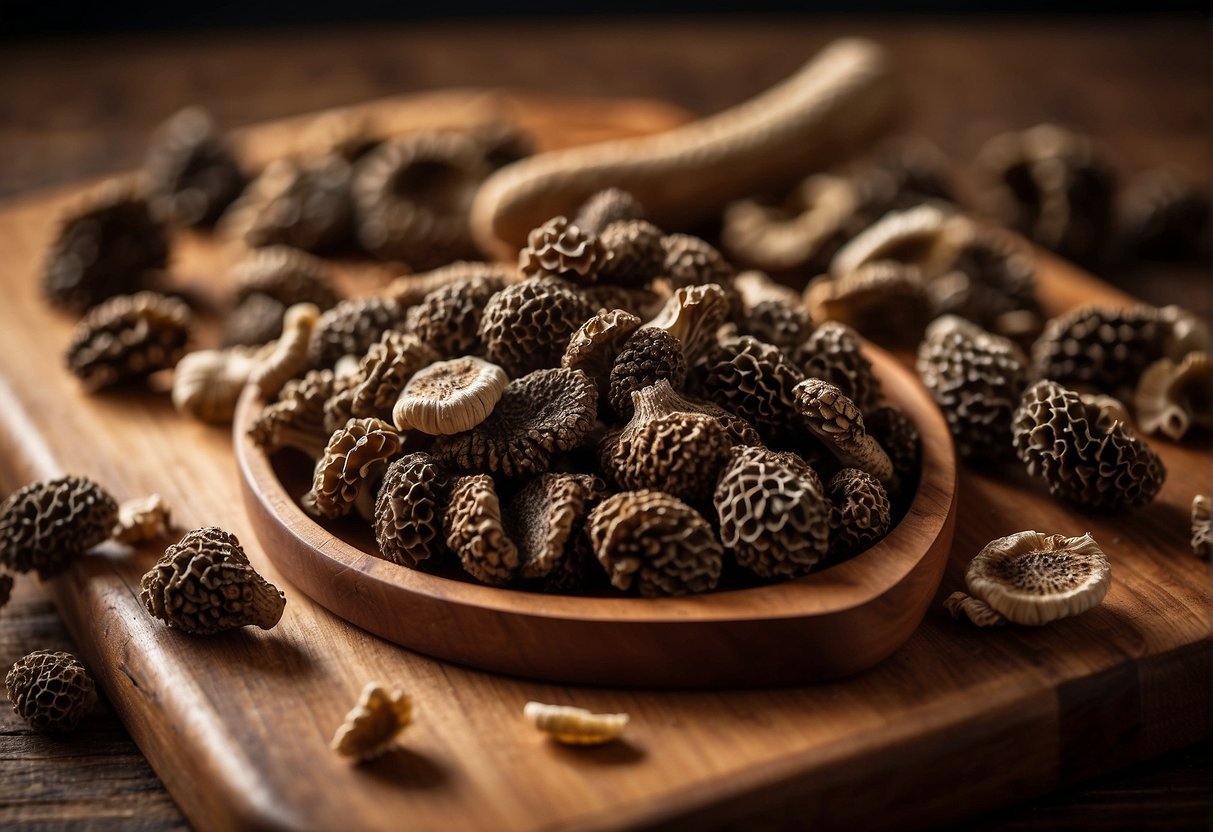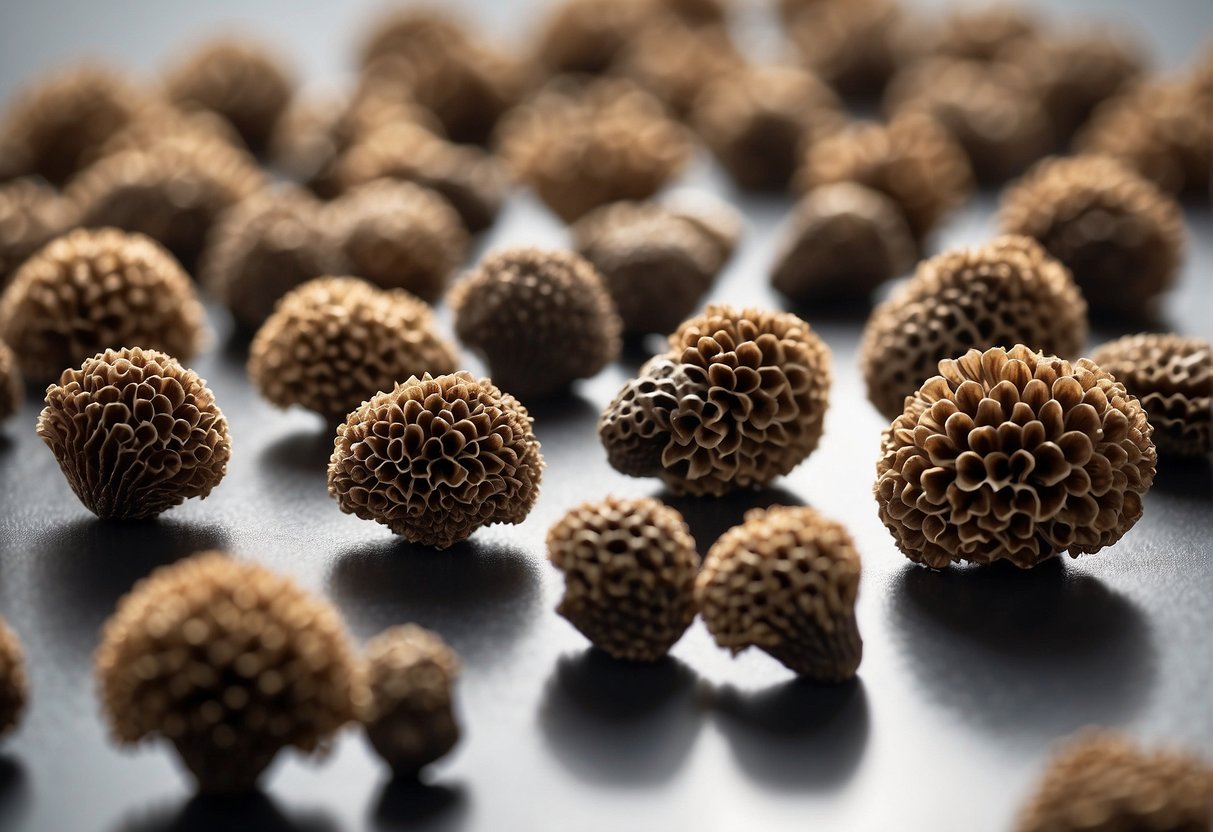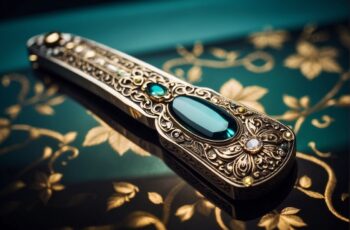Dried morel mushrooms are a culinary delight treasured by chefs and food enthusiasts alike. These prized fungi are renowned for their robust flavor and unique, sponge-like appearance. Morels grow wild in wooded areas and are foraged in the springtime, but when dried, they can be enjoyed year-round. The drying process concentrates their earthy and nutty taste, making them a versatile ingredient that can elevate a wide variety of dishes.

When you have dried morels on hand, you unlock a world of cooking potential. Rehydrating them is simple and allows you to use them as you would fresh morels. Whether incorporated into a creamy sauce, added to a risotto, or folded into a savory pastry, dried morels infuse meals with an intense gourmet flavor. Furthermore, they’re a source of protein and fiber and add a delightful texture to any dish.
Key Takeaways
- Dried morel mushrooms offer a concentrated flavor that enhances numerous recipes.
- They can be rehydrated easily, making them a convenient substitute for fresh morels.
- Including dried morels in your dishes adds not only taste but valuable nutrients as well.
Understanding Morels
In exploring the world of morels, you’ll encounter their unique characteristics and learn how to identify them correctly. It’s crucial to distinguish between true and false morels to avoid any toxic mistakes.
Identification and Foraging
When foraging for morels, look for wrinkled, honeycomb-like caps perched on a hollow stem. True morels vary in color from tan to dark brown and are found in the woods, often thriving near elm trees and in areas with rich soil. False morels are similar in appearance, but their caps are often irregularly shaped and attached at the top; these can be toxic.
- Where to forage: Seek out morels in wooded areas, especially where there’s been recent growth or after a forest fire.
- Caution: Always compare what you find against a reliable guide to ensure you’ve got true morels.
Varieties and Seasonality
There are several varieties of morels, which can primarily be found during the spring months, aligning with their unique life cycle. As their mycelium networks regenerate in the right conditions, their fruiting bodies — or the morels you forage — emerge from the soil.
- Peak season: Typically from late March through May in many regions.
- Varieties: Common types include the Black Morel, Yellow Morel, and Half-free Morel.
Remember, the environment where morels grow is part of their natural life cycle, and their appearance is a signal of the ecosystem’s health. As you search, honor the woods and its inhabitants by foraging responsibly and preserving the mycelium and spores for future seasons.
Culinary Uses
Dried morel mushrooms are renowned for their intense earthy flavor, making them a coveted ingredient among culinary enthusiasts. You’ll find that they add a depth of flavor to your dishes that fresh mushrooms simply can’t match, whether you’re looking to enrich a risotto or create a hearty stew.
Rehydration Techniques
Before using dried morels, you’ll need to rehydrate them to unlock their signature flavor. Begin by placing your morels in a bowl and cover them with hot water. Let them soak for about 20 minutes, until they become plump and regain their unique texture. Patience here is key; give them the time they need. A pro tip is to save the soaking liquid; it’s packed with flavor and can be used to impart an umami punch to sauces and risottos.
Incorporating into Dishes
Once rehydrated, these gems are incredibly versatile in the kitchen. For a classic approach, sauté morels in butter or olive oil with fresh herbs, adding them to risottos or soups for a nutty and meaty flavor boost. They pair excellently with venison and other game meats, heightening the dish’s richness. When aiming for a crispy texture, coat your morels in flour and fry until golden. Always remember, with dried morels, a little goes a long way in transforming your recipes into delicious creations that sing with an earthy flavor and unique texture.
Preservation and Storage
When you’ve had success foraging and find yourself with a bounty of morel mushrooms, proper preservation and storage techniques are key to maintaining their quality and extending their shelf life. Dried morels are a fantastic way to enjoy these wild treasures year-round. Here’s what you need to know to ensure that your treasured morels stay fresh and flavorful.
Drying Process:
- Clean your morels thoroughly, removing any dirt or debris.
- Slice them in half lengthwise to expedite the drying process.
- Spread the morels on a baking sheet or a dehydrator tray in a single layer.
- Dry them until completely dehydrated at a low temperature; this should take about 8-10 hours in a dehydrator or in an oven set to the lowest possible temperature.
Proper Storage:
- Once dried, cool your morels to room temperature.
- Seal them in airtight containers, such as zip-close bags or jars with tight seals.
- Place a dessicant pack in the container if available, to absorb any excess moisture.
Shelf Life in the Refrigerator:
- Refrigerator: For short-term storage, your airtight container of dried morels can be kept in the refrigerator where they’ll stay good for a few weeks.
Long-Term Storage:
- For long-term storage, keep your dried morels in a cool, dark place.
- Properly stored, dried morels can remain edible for up to a year or even longer. Just be sure to check on them occasionally for any signs of moisture or spoilage.
By ensuring you follow these steps, you’ll be savoring the taste of your foraged morels long after the spring season has faded.
Health and Safety Considerations

When enjoying the unique taste of dried morel mushrooms, your wellbeing comes first. Understanding their nutritional benefits and how to distinguish safe consumables from toxic look-alikes is paramount.
Nutritional Value
Morel mushrooms are a treasure trove of nutrients. A mere 100-gram serving packs a substantial 12.2 milligrams of iron, which is the full daily requirement for men and over half for women—critical for your outdoor activities that demand endurance. Here’s a snapshot of what these fungi bring to your table:
- Vitamins: B-vitamins are abundant in morels, contributing to your energy levels and overall brain function.
- Fiber: They provide dietary fiber, promoting good digestive health.
- Minerals: Apart from iron, you’ll find calcium and phosphorus, which are vital for bone health.
- Low in Ash: Morels have a low ash content, making them purer and higher quality.
- Flavor: Their nutty and intense flavor enriches any meal after a long day in the wild.
Identifying and Avoiding Toxic Varieties
Steer clear of toxic look-alikes to ensure your foraging adventure doesn’t turn sour. While morels are distinct with their honeycomb-like exterior, their doppelgangers—known as false morels—can deceive the untrained eye and induce unpleasant health effects.
- Cap Shape: True morels have a uniform, deeply pitted cap. False ones often have a wrinkled or irregular surface.
- Interior: Slicing a morel lengthwise should reveal a completely hollow interior. If it’s chambered or cottony, discard it—it’s not a true morel.
- Color: Authentic morels range from tan to dark brown, while many false ones are reddish or have a different hue.
Remember, if you’re uncertain about a mushroom’s identity, opting for a store-bought or professionally harvested morel can save your day. When it comes to foraging, it’s better to be safe than sorry—especially as you preserve these treats for the leaner seasons, ensuring your health benefits extend throughout the year.


